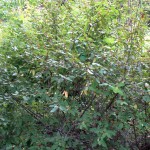By Catherine Haug, June 14, 1017 (Photo, right, of a native shrub in my yard, is by Catherine)
We all love our wildlife, and there are lots of things you can do to help protect them, right in your yard. The following recommendations come from the Wildlife Land Trust (1) [with comments by me or other members of our team in square brackets]. Note that some of the recommendations also help you, like bat houses.
In your home and yard:
- Seek humane solutions when a conflict arises with wildlife in your home or yard.
- Support migratory birds and other wildlife by replacing unused areas of lawn with native trees, shrubs, wildflowers and grasses that provide food and cover. [This is especially important if your ‘yard’ covers more than a couple acres. For more about Montana Native trees and other plants, the Montana Native Plant Society (2), Montana NativePlants for Pollinator-Friendly Plantings (3), Native Yards (4)].
- [Don’t feed deer, but plant some native shrubs that deer like to graze].
- Maintain a birdbath with clean, fresh water to help your backyard birds and migrating birds needing a rest stop.
- Install bat houses — happy bats, fewer bugs! [See National Wildlife Federation for how to build your own bat house (5)].
Read on for more recommendations.
- Provide wildlife cover and shelter by creating a brush pile with cut or fallen branches. [This can be tricky in forest fire season; keep it an adequate distance from your house.]
- Don’t allow hunting or trapping on your property. [This applies for the typical residential property. People with large farms/ranches should use their own judgement. I personally would not allow trapping because I believe it is cruel.]
- Recycle yard waste, but when doing spring cleanup, leave behind twigs and leaves for nesting birds to use.
- Feed your pets indoors, or keep pet food in securely covered containers to reduce temptation for [bears], raccoons and skunks.
- Keep cats indoors — for their own safety as well as for the sake of birds and other wildlife. [Again, use your own judgement; if you have a mouse or rat problem, and your cat is a good mouser, this may not apply…]
- Reduce or even eliminate the need to use pesticides and fertilizers in your garden by choosing native plants and natural pest control methods. [Keep a compost pile, mulch your garden, especially where ground would otherwise be bare to minimize problems.]
- Reduce your own energy consumption and help promote policies to prevent climate change.
- Turn down the heat and put on a sweater — uses less energy and saves you money.
In your community:
- Support local and regional efforts to protect natural habitats and wildlife corridors.
- Encourage wildlife-friendly practices in your community.
- Advocate for stronger laws against poaching and captive hunting.
- Volunteer at your local nature centers, native plant societies, and wildlife sanctuaries. [See link to Montana Native Plant Society (2), below.]
- Teach children respect for wildlife and wildlife habitat.
- Watch for wildlife when driving, especially at dawn and dusk. Remember, when one animal crosses, another may follow closely behind.
- Don’t encourage wildlife to trust humans — a fed bear is a dead bear.
- Support local open space initiatives.
- Pick up trash during hikes.
- Buy local foods and goods.
- Buy organically grown produce to reduce pesticide runoff.
References
- Wildlife Land Trust
- Montana Native Plant Society (mtnativeplants.org) and their landscaping page (mtnativeplants.org/Native%20Plant%20Landscaping)
- USDA’s Natural Resources Conservation Service (NRCS): Montana Native Plants for Pollinator-Friendly Plantings (pdf)(nrcs.usda.gov/Internet/FSE_PLANTMATERIALS/publications/mtpmcbr11694.pdf)
- Native Yards, Missoula MT: (nativeyards.com)
- National Wildlife Federation on building your own bat house (nwf.org/Garden-For-Wildlife/Cover/Build-a-Bat-House.aspx)
Tags: conservation, native plants, wildlife
